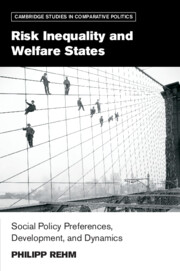Book contents
- Frontmatter
- Dedication
- Contents
- List of Figures
- List of Tables
- Acknowledgments
- 1 Introduction
- 2 Theoretical Framework
- 3 Preference Formation
- 4 Risk Perceptions
- 5 Risk Pools and Social Policy Generosity
- 6 Risk Pools and Retrenchment – German Reunification
- 7 Risk Pools and Social Policy Adoption
- 8 Crises and Social Policy
- 9 Conclusion
- References
- Index
- Other Books in the Series
4 - Risk Perceptions
Published online by Cambridge University Press: 05 May 2016
- Frontmatter
- Dedication
- Contents
- List of Figures
- List of Tables
- Acknowledgments
- 1 Introduction
- 2 Theoretical Framework
- 3 Preference Formation
- 4 Risk Perceptions
- 5 Risk Pools and Social Policy Generosity
- 6 Risk Pools and Retrenchment – German Reunification
- 7 Risk Pools and Social Policy Adoption
- 8 Crises and Social Policy
- 9 Conclusion
- References
- Index
- Other Books in the Series
Summary
Every year, about 30 Americans die because they are struck by lightning. About 45,000 die as a result of lack of health insurance. Excluding the 9/11 atrocities, which killed 2,997 people and injured more than 6,000, fewer than 500 people died in the United States of terrorist attacks between 1970 and 2010. Every single month, millions of Americans lose their jobs. Yet we know more about people's perception of the risk of being hit by lightning or being the victim of a terrorist attack than their perceptions of the risk of losing their health insurance or their job.
In fact, the rich literature on risk perceptions largely ignores risks covered by social policy programs, such as old age, ill health, accident, and unemployment. Because much of what governments do is the management of social policy risks, and because risk perceptions motivate political behavior, this is no small omission. Two questions are particularly relevant: How do citizens form risk perceptions? And are risk perceptions accurate? With respect to social policy risks, neither of these questions has been explored systematically in the existing literature. This chapter will address them, in reverse order.
The next section explores whether risk perceptions are accurate. Using the Survey of Risk Perceptions and Insecurity (SERPI), an original panel survey, I find that subjective risk perceptions are fairly realistic, at least in relative terms. I then analyze the correlates of risk perceptions and find that one of the best predictors of the subjective probability of experiencing a bad event at time t is the actual occurrence of that bad event at future time t + 1. Next, I turn to the question of how risk perceptions are formed. Since people seem to have a good sense of whether they are exposed to higher or lower risk, I analyze the characteristics of social policy risks in order to explore how people can form reasonably accurate risk perceptions. I find that social policy risks (in the United States) are correlated in three ways: over time, across domains, and within networks. I conclude by showing that respondents draw on the clustering of shocks over time and within network as sources of information in order to form their own risk perceptions.
Information
- Type
- Chapter
- Information
- Risk Inequality and Welfare StatesSocial Policy Preferences, Development, and Dynamics, pp. 59 - 91Publisher: Cambridge University PressPrint publication year: 2016
